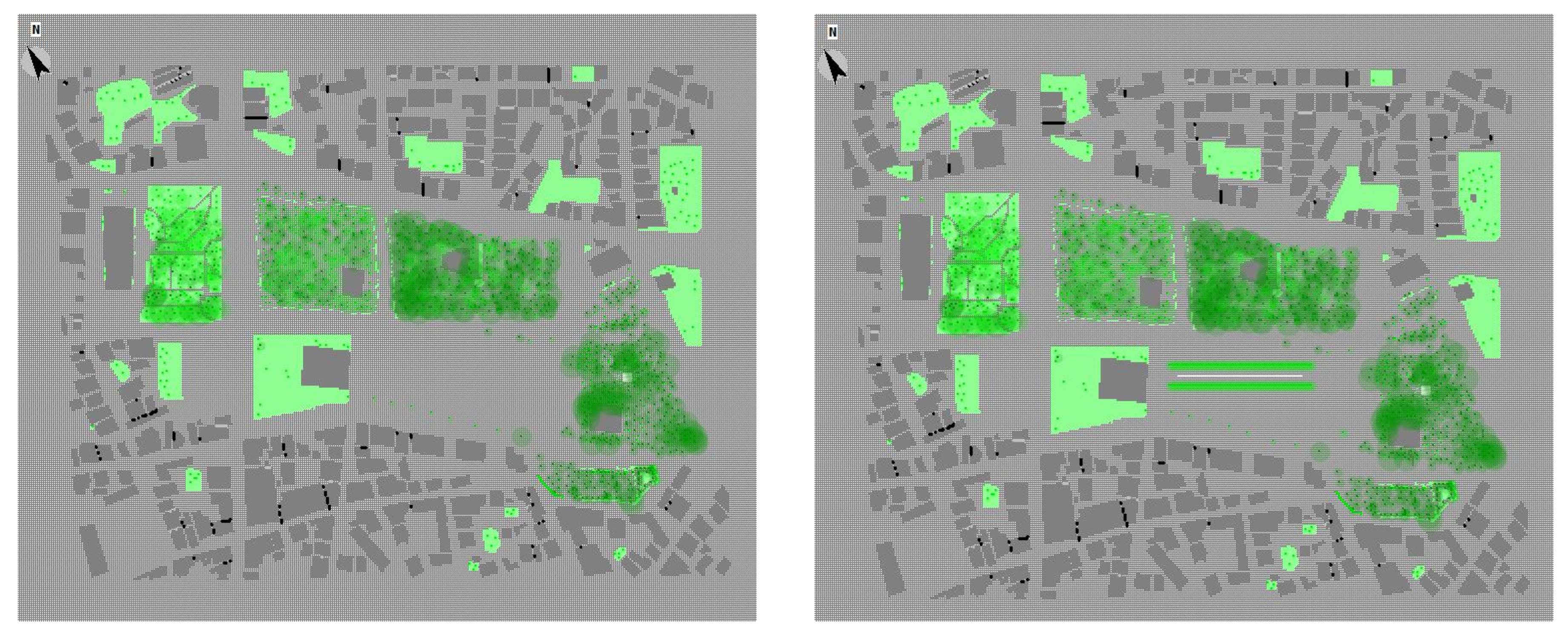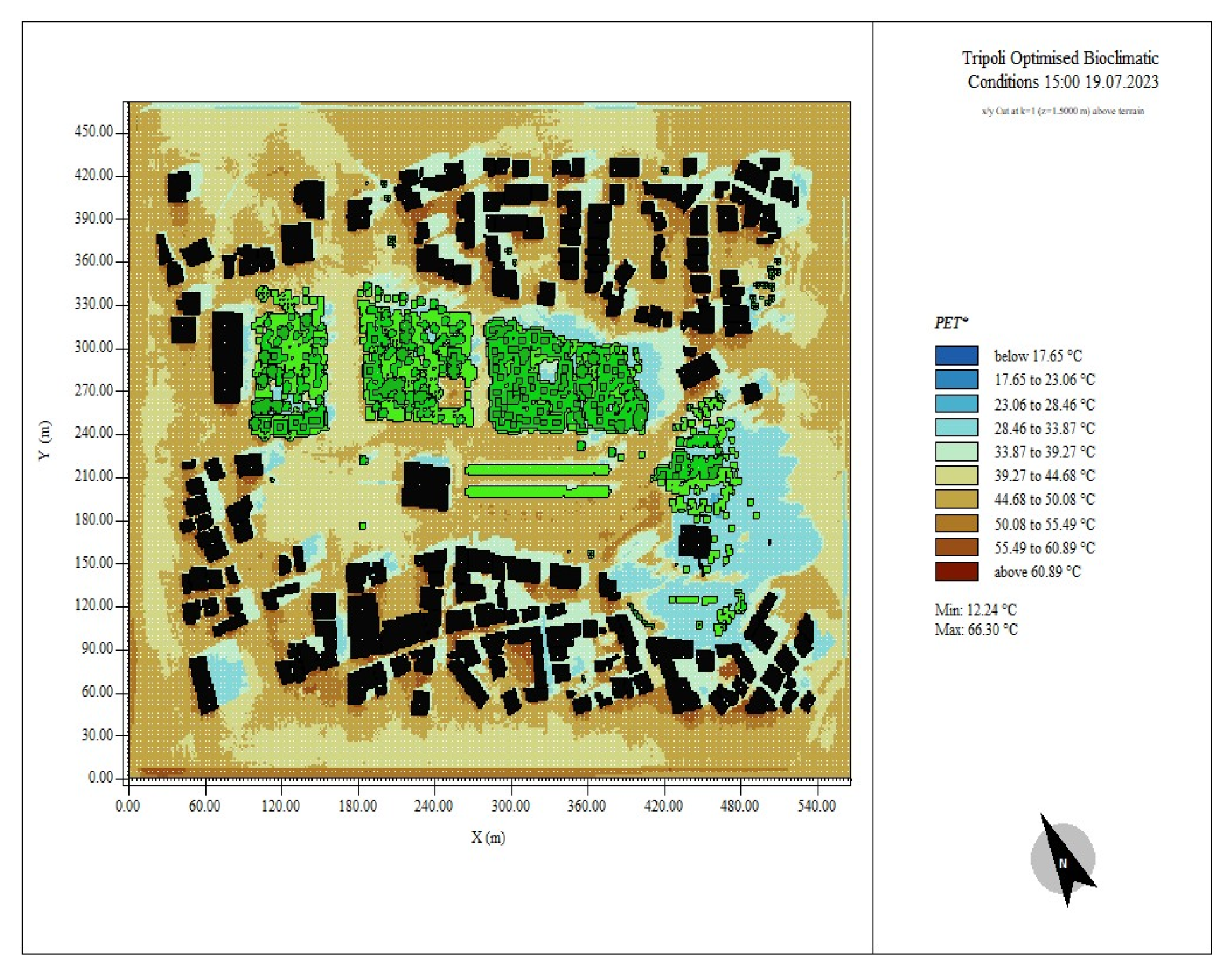BIOASTY: Sustainable Urban Design for Climate Resilience †
Abstract
1. Introduction
2. Materials and Methods
- Building Configurations: Detailed data were collected on the height, shape, and material properties of buildings in the study area, including architectural designs, construction materials, and spatial arrangements.
- Surface Materials: Information on the thermal and reflective properties of materials such as asphalt, concrete, grass, and vegetation was gathered to ensure accurate simulation of surface temperatures and heat exchange.
- Vegetation Coverage: The types, density and spatial distribution of vegetation—including trees, shrubs and lawns—were mapped. Vegetation plays a critical role in modifying microclimates through shading and evapotranspiration.
- Meteorological Data: Local weather conditions, including air temperature, humidity, wind speed and direction and solar radiation, were input into the model to reflect real atmospheric conditions.
3. Results
3.1. Assessment of the Current Situation
3.2. Optimized Bioclimatic Conditions
4. Conclusions
- The increase in green spaces for heat absorption, the provision of shading and the promotion of evaporative transpiration lead to a reduction in the PET index by mitigating the intensity of the Urban Heat Island phenomenon.
- The application of shading structures, tree lines on the sides of the streets and tree planting in public places (stadiums, parks, playgrounds) offers protection from direct solar radiation, taking into account the meridian arc of the sun by optimizing human thermal comfort.
- The integration of aquatic features (fountains, streams, lakes) into the public urban space works effectively for absorbing heat from the built urban environment, dissipating excess heat through evaporation and creating refreshing microclimates.
- In addition, the model’s optimization features allow for fine-tuning of the above scenarios to achieve better results.
Author Contributions
Funding
Institutional Review Board Statement
Informed Consent Statement
Data Availability Statement
Conflicts of Interest
References
- Nastos, P.T.; Kapsomenakis, J. Regional climate model simulations of extreme air temperature in Greece. Abnormal or common records in the future climate? Atmos. Res. 2015, 152, 43–60. [Google Scholar] [CrossRef]
- Guerreiro, S.B.; Dawson, R.J.; Kilsby, C.; Lewis, E.; Ford, A. Future heatwaves, droughts and floods in 571 European cities. Environ. Res. Lett. 2018, 13, 034009. [Google Scholar] [CrossRef]
- Bruse, M.; Fleer, H. Simulating surface plant air interactions inside urban environments with a three-dimensional numerical model. Environ. Model. Softw. 1998, 13, 373–384. [Google Scholar] [CrossRef]
- Tsoka, S.; Tsikaloudaki, A.; Theodosiou, T. Analyzing the ENVI-met microclimate model’s performance and assessing cool materials and urban vegetation applications—A review. Sustain. Cities Soc. 2018, 43, 55–76. [Google Scholar] [CrossRef]
- Höppe, P. The physiological equivalent temperature—A universal index for the biometeorological assessment of the thermal environment. Int. J. Biometeorol. 1999, 43, 71–75. [Google Scholar] [CrossRef] [PubMed]
- Lee, H.; Mayer, H.; Chen, L. Contribution of trees and grasslands to the mitigation of human heat stress in a residential district of Freiburg, Southwest Germany. Landsc. Urban Plan. 2016, 148, 37–50. [Google Scholar] [CrossRef]
- Michalakes, J.; Dudhia, J.; Gill, D.; Henderson, T.; Klemp, J.; Skamarock, W.; Wang, W. The Weather Research and Forecast Model: Software Architecture and Performance. In Proceedings of the Eleventh ECMWF Workshop on the Use of High Performance Computing in Meteorology, Reading, UK, 25–29 October 2004; Zwieflhofer, W., Mozdzynski, G., Eds.; World Scientific: Singapore, 2005; pp. 156–168. [Google Scholar] [CrossRef]




Disclaimer/Publisher’s Note: The statements, opinions and data contained in all publications are solely those of the individual author(s) and contributor(s) and not of MDPI and/or the editor(s). MDPI and/or the editor(s) disclaim responsibility for any injury to people or property resulting from any ideas, methods, instructions or products referred to in the content. |
© 2025 by the authors. Licensee MDPI, Basel, Switzerland. This article is an open access article distributed under the terms and conditions of the Creative Commons Attribution (CC BY) license (https://creativecommons.org/licenses/by/4.0/).
Share and Cite
Progiou, A.G.; Polychroni, I.; Nastou, M.P.P.; Charalampopoulos, I.; Benetatos, C.; Gkikas, A.; Spyrou, C.; Solomos, S.; Eleftheratos, K.; Zerefos, S.; et al. BIOASTY: Sustainable Urban Design for Climate Resilience. Environ. Earth Sci. Proc. 2025, 35, 22. https://doi.org/10.3390/eesp2025035022
Progiou AG, Polychroni I, Nastou MPP, Charalampopoulos I, Benetatos C, Gkikas A, Spyrou C, Solomos S, Eleftheratos K, Zerefos S, et al. BIOASTY: Sustainable Urban Design for Climate Resilience. Environmental and Earth Sciences Proceedings. 2025; 35(1):22. https://doi.org/10.3390/eesp2025035022
Chicago/Turabian StyleProgiou, Athena G., Iliana Polychroni, Marina Panagiota P. Nastou, Ioannis Charalampopoulos, Charilaos Benetatos, Antonis Gkikas, Christos Spyrou, Stavros Solomos, Konstantinos Eleftheratos, Stelios Zerefos, and et al. 2025. "BIOASTY: Sustainable Urban Design for Climate Resilience" Environmental and Earth Sciences Proceedings 35, no. 1: 22. https://doi.org/10.3390/eesp2025035022
APA StyleProgiou, A. G., Polychroni, I., Nastou, M. P. P., Charalampopoulos, I., Benetatos, C., Gkikas, A., Spyrou, C., Solomos, S., Eleftheratos, K., Zerefos, S., & Nastos, P. T. (2025). BIOASTY: Sustainable Urban Design for Climate Resilience. Environmental and Earth Sciences Proceedings, 35(1), 22. https://doi.org/10.3390/eesp2025035022











